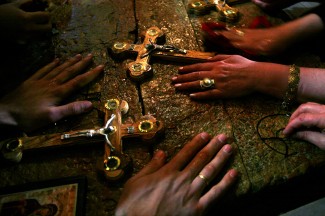
Other rites, you ask? Yes! In the one, holy, catholic, and apostolic Church there are a total of seven rites. These rites represent different liturgical traditions where the Sacraments are celebrated in a way that makes sense in the context of a particular culture without changing their essential form or matter. The seven rites are Latin, Byzantine, Alexandrian, Syriac, Armenian, Maronite, and Chaldean. Each rite has equal dignity and equal responsibilities. Each rite possesses its own hierarchy and its own canon law. Each rite is faithful to the pope and recognizes him as its highest earthly shepherd.
Last month we were invited to attend the Divine Liturgy (or Mass to us Latin Rite Catholics) at a local Romanian Byzantine Catholic parish where our oldest daughter participates in Little Flowers Girls Club. I was reminded of a phrase Pope St. John Paul II used on several occasions during his papacy: “The Church must breathe with her two lungs.” Both the Eastern and Western rites of the Catholic Church are authentically Catholic. Each rite has something unique to reflect about what the Church is called to be.
This Advent, I challenge you to try breathing with both lungs. If you can, find an Eastern Rite parish in your community. Attend their Sunday Liturgy and don’t worry, it fulfills your Sunday obligation! During Advent, we reflect not only on Jesus’ coming into the world as a newborn baby but also on his promise to come again. Fostering unity and understanding within the Church is an important part of our preparation for his coming again. So, go ahead! Get to know the other “lung” of the Church this Advent! If your experience is anything like ours, you’ll be glad you did.
What can you expect at an Eastern Rite liturgy? That can vary vastly from rite to rite, but here are a few things we observed that could come in handy.
Don’t be surprised if …
- The priest is wearing a wedding ring. Eastern Rite priests can be married as long as they are married before they are ordained. The priest’s wife and children often play an important role in parish life.
- You see a lot of icons. Eastern Rite Catholics share a common heritage with Orthodox Christians and the veneration of icons is an important aspect of this liturgical legacy. Icons are venerated (which means honored, not worshipped) because they represent holy scenes and individuals to whom reverence is due. You may notice people kissing or otherwise reverencing icons upon entering the church. Feel free to join in, if you feel comfortable. If you’d like to participate in this, a good rule is to do what everyone else is doing. Or when in Byzantium, do as the Byzantines do.
- People don’t genuflect before sitting in the pews. Eastern Catholics may bow before entering their pew, but they do not genuflect. Because Sunday is a celebration of Christ’s Resurrection and our freedom from the bondage of death, Eastern Rite Catholics do not genuflect out of respect but stand humbly before the Lord.
- People cross themselves “backwards.” In Eastern Rite communities (as well as Orthodox communities), people cross themselves from right to left as opposed to left to right. This was the way all Christians blessed themselves until the Middle Ages. It gets a bit murky when you delve into the “why” of this change in the West. If you happen to have any clues, please let me know in the comments section! Feel free to cross yourself in the manner in which you are accustomed. People, if they even notice, will simply recognize you as a Latin Rite Catholic.
- They pray for the pope … a lot. Eastern Rite Catholics pray for the pope by name many times throughout the Liturgy. Check out this great video of Pope St. John Paul II celebrating the Eastern Rite Divine Liturgy at St. Peter’s Basilica in Rome.
- Communion is received differently. At an Eastern Rite Liturgy, you do not put your hands out to receive the Body of Christ. Generally speaking, the priest will put the consecrated host (which, by the way, is leavened bread) that has been dipped in the consecrated wine on a spoon and you will receive it in your mouth. He will probably quietly ask you for your first name and then say, “(Name) servant of God receives the precious and all holy and most pure Body and Blood of our Lord and God, Jesus Christ for the remission of his sins and for life everlasting.”
- Everyone heads to the front of the church instead of the back after the Liturgy. People come forward to greet the priest and to reverence the cross by kissing it. Afterwards, you may be offered blessed bread left over from larger loaves cut for the Eucharist but not consecrated called Antidoron. I think this was out little peoples’ favorite part of the Liturgy.
Get going and discover on your own. Getting to know our Eastern Rite sisters and brothers is necessary in cultivating a deeper understanding of Christ and his Church. Breathe with both lungs this Advent and drop me a line to let me know where you visited and what you thought!